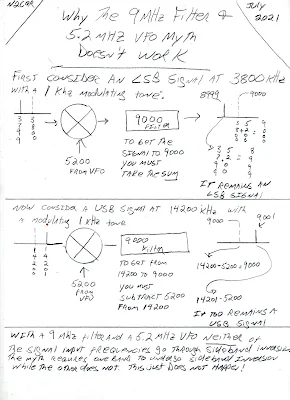Don't get me wrong -- I'm a huge fan of Doug DeMaw. His books and articles are a treasure trove for ham radio homebrewers. Also, Doug was an honest guy who admitted in the preface to his QRP book that at times he did not fully understand the circuits he was building; that kind of honesty is rare, and is very helpful to amateurs who struggle to understand the circuits we work on.
But everyone makes mistakes, and Doug made one in his "W1FB Design Notebook." I present it here not as a "gotcha" effort to nitpick or sharpshoot a giant of homebrew radio, but because this error illustrates well the depth of the 75 LSB/20 USB myth, where it comes from, and how important it is to really understand sideband inversion. Here is the mistake:
That's just wrong. A receiver built like this will not allow you to listen to 75 LSB and 20 USB "without changing the BFO frequency." (Am I the first one to spot this error? Didn't anyone build this thing, only to discover that it, uh, doesn't work?)
Here's a little drawing that I think illustrates why the mythical scheme will not work:
All confusion about sideband inversion could be avoided with the simple application of what I think we should call "The Hallas Rule":
"Sideband reversal occurs in mixing only if the signal with the modulation is subtracted from the signal that isn't modulated."
Be careful here: I think some arithmetic carelessness is responsible for much of the myth. Taking the difference frequency is not enough to produce sideband inversion. Read the Hallas Rule carefully: For sideband inversion to occur, the signal with the modulation must be subtracted FROM the signal without the modulation.
---------------------------------------------
About the Swan 240's SSB generation scheme:
I first stumbled on this problem when building my first SSB transmitters in the Azores. I was using a VXO, and a filter pulled out of a Swan 240 (5.173 MHz). I started with VXO crystals at around 12.94 MHz. The rig worked, but I couldn't pull the VXO crystals very far. So I switched to crystals at around 23.3 MHz (you can pull higher frequency crystals farther). But look what happened: My Carrier Oscillator frequency had been set up to receive USB signals on 17 Meters. With the 12.94 MHz rocks, that worked fine: 18.150-12.977 = NO INVERSION. But it all changed when I went to the 23 MHz VXO rocks: 23.323-18.150 = INVERSION! This had me scratching my head a while. I had to draw myself little spectrum pictures (like the one above) before I realized what had happened. To get it to work -- to get it to produce USB on 17 meters -- I had to move the Carrier Oscillator to the other side of the passband. Good thing that Swan 240 came with TWO BFO crystals (5.1768 MHz and 5.1735 MHz). I just had to change the crystal.
For 75 and 20 meters, the Swan 240 uses the correct 5.173 MHz filter with a 9 MHz VFO to get the happy situation of 75 meter LSB and 20 Meter USB WITHOUT changing the BFO/Carrier Oscillator frequency. This is the Mythbuster scheme. Unlike Doug's receiver, it works. The scheme also works in the Swan 240 on 40 meters because for 40 the Swan rig has the VFO running from 12.073 MHz to 12.513 MHz. Here too, no change in the BFO/Carrier Oscillator frequency is needed. But the Swan recommended a modification that would allow operation on 20 LSB and 75/40 USB! It used a BFO/Carrier Oscillator crystal of 5.1765 MHz and a switch mounted on the front panel. Luckily, my junker Swan (acquired from HI8P in the Dominican Republic) had the second crystal -- mine was 5.1768 MHz. It was that crystal that allowed me to get my Azorean SSB transmitter to work using the 23.9 MHz VXO rocks.














